this post was submitted on 25 Sep 2024
1192 points (98.9% liked)
pics
19680 readers
61 users here now
Rules:
1.. Please mark original photos with [OC] in the title if you're the photographer
2..Pictures containing a politician from any country or planet are prohibited, this is a community voted on rule.
3.. Image must be a photograph, no AI or digital art.
4.. No NSFW/Cosplay/Spam/Trolling images.
5.. Be civil. No racism or bigotry.
Photo of the Week Rule(s):
1.. On Fridays, the most upvoted original, marked [OC], photo posted between Friday and Thursday will be the next week's banner and featured photo.
2.. The weekly photos will be saved for an end of the year run off.
Instance-wide rules always apply. https://mastodon.world/about
founded 1 year ago
MODERATORS
you are viewing a single comment's thread
view the rest of the comments
view the rest of the comments


What time of year in each photo?
Are you suggesting that Antarctica typically thaws out in the summer?
Is this Antarctica or the Arctic? The title said the Arctic, but you said Antarctica and the mountains do remind me more of the south than the north.
I assumed it was northern Canada, Russia, Iceland, or one of the other land masses at the edge of the Arctic Ocean.
Svalbard, according to the photographer. It's the second image in that gallery, there's a little "info" button below the bottom right of the image
Actually that’s all.
What is this, an Arctic for Ants?!
Would you say it’s ant-antarctic?
Mountains of ice melt in the summer then the water refalls in the fall and winter as snow and freezing rain in truly apocalyptic amounts. Rebuilding the ice mountains to start the process over.
Can't tell if a joke or if user doesn't understand how glaciers work.
He doesn't understand glaciers.
Glaciers are made from snow piling up over centuries.
Some of it melts each winter, but over time, the glacier should stay about the same.
If this glacier is melted, that means it's been more melting than building back up for the last century. It's a sign of global warming.
Joke
Given that the sun is up at roughly the same amount, and at the poles the sun remains consistently up or down according to the season, I think we can rightly assume these two photos are taken at least approximately at similar times of the year.
Also, are you trying to insinuate that 100+ foot tall glaciers are somehow "seasonal?" Because they aren't.
Glaciers actually do retreat and advance seasonally or on even longer cycles. Some have terminuses that move back and forth literal miles. One of the key indicators of climate change is the fact that globally, glaciers are retreating more than they're advancing on average.
Sure, but completely disappear in a season as if that's "normal?" No.
I'm sure it's just a smidge of winter snow build up. No need to be alarmed
Question. How fast do you think glaciers reach that height?
I'm not your thread's OP but I want to know the same question (what were the seasons) because no, I don't know how fast glaciers reach that height either. Nothing about that implies denial of the validity, it's a question to help quantify the change. Varying 10ft between seasons means this is a massive change regardless of season. Varying 100ft, not so much. No, I don't beleive it'd actually be 100fr of change in 6 months, but I could see it being more than 10ft.
Did you think my question was a veiled attempt at climate change denial, lol?
What was it, ignorance and stupidity?
A question.
"I'm just asking questions!"
Are you trolling? The seasonal variation in arctic glaciers is negligible.
Is the boat the same distance from the shore?
No the question isn't time of year but of time of day.
See it was mid morning so the glaciers all left for tea.